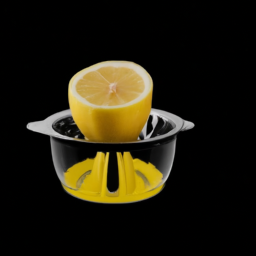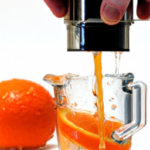I really love starting my day with a refreshing glass of orange juice. Its sweet and tangy flavor has a special way of energizing me and getting me ready for the day ahead.
But have you ever wondered how much juice you can actually get from one orange? It’s a question that’s been on my mind lately, so I did some research to find out.
There are a lot of factors that can affect how much juice you can extract from an orange, including the variety of orange, its ripeness, how it’s prepared, and the juicing method you use.
In this article, I’ll be exploring these factors in detail to help you get the most juice possible from your oranges. I’ll also be sharing some delicious orange juice recipes and discussing the nutritional benefits of this refreshing beverage.
So, let’s dive in and find out just how much juice we can get from one orange!
Key Takeaways
- The amount of juice extracted from an orange can be affected by factors such as ripeness, temperature, and juicing method.
- Valencia and Navel oranges are the best varieties for juicing, and proper preparation involves removing the white pith.
- Cold pressing yields high-quality juice, while rolling or microwaving oranges can increase juice yield.
- Consuming fresh orange juice in moderation can provide essential vitamins and minerals, but store-bought juice may not be as nutritious.
Factors That Affect Juice Yield
Did you know that the amount of juice you can get from one orange is affected by factors such as ripeness, temperature, and juicing method?
When it comes to juice extraction, it’s important to understand the anatomy of citrus fruit. Oranges have two parts that contain juice: the pulp and the juice sacs. The pulp is the meaty part of the orange that surrounds the juice sacs. The juice sacs are small, translucent pockets of liquid that contain the actual juice.
Ripeness is a key factor in determining juice yield. The riper the orange, the more juice it will yield. This is because the juice sacs are more developed and plump in ripe oranges.
Temperature also plays a role in juice extraction. When oranges are cold, the juice sacs become less plump and yield less juice.
Juicing method is another important factor. Hand-squeezing an orange will yield less juice than using a mechanical juicer because the latter is able to extract juice from the pulp and juice sacs more efficiently.
Understanding these factors can help you choose the right orange for juicing.
Choosing the Right Orange
When it comes to juicing oranges, it’s important to choose the right variety and ensure that they’re ripe. The best varieties for juicing, in my experience, are Valencia and Navel oranges. They have a high juice content and are easy to peel.
To select ripe oranges, I always look for a bright and uniform color, a firm texture, and a sweet fragrance.
Best Varieties for Juicing
You’ll want to choose a variety of orange that’s known for its juiciness and flavor when making your morning juice.
Some of the best varieties for juicing include Valencia, Navel, and Blood oranges. These oranges have high juice quality and acidity levels, making them perfect for juicing.
Valencia oranges are known for their sweet and juicy flavor, as well as their high juice yield. Navels, on the other hand, have a lower acidity level and a sweeter taste, making them perfect for those who prefer a milder flavor.
Blood oranges, with their deep red flesh and unique flavor, are also great for juicing.
When choosing your oranges, look for those that’re firm and heavy for their size. This’ll ensure that they’re ripe and full of juice.
How to Select Ripe Oranges
Selecting ripe oranges is crucial for getting the most flavorful and juicy juice possible, so it’s important to know what to look for when choosing your fruit.
The first step in selecting ripe oranges is to identify unripe ones. Unripe oranges are usually harder and lighter in weight. It’s best to avoid selecting oranges with green spots or blemishes on the skin, as these may indicate that the fruit is not yet ripe.
Once you have selected your ripe oranges, it’s important to store them properly to ensure maximum freshness. Oranges can be stored at room temperature for up to a week or in the refrigerator for up to two weeks.
To get the most juice out of your oranges, it’s also helpful to prepare them properly before juicing.
Preparing the Orange
To get the most juice from an orange, it’s important to first cut it properly, even if you’re worried about wasting some of the fruit.
First, start by washing the orange thoroughly to remove any dirt or residue on the skin. Then, use a sharp knife to cut off both ends of the orange. This will provide a stable base for the fruit to stand on while you cut the rest of it.
Next, use a peeling technique that works best for you. Some people prefer to use a vegetable peeler, while others prefer to use a paring knife. Regardless of the technique you choose, make sure to remove as much of the white pith as possible without removing too much of the orange flesh.
If you want to add some zest to your juice, use a zester or grater to remove the brightly colored outer layer of the skin before juicing.
With the orange properly prepared, you’re ready to move on to the next step: juicing methods.
Juicing methods can vary depending on the equipment you have available. From manual juicers to electric juicers, there are many options to choose from.
However, one of the most basic and effective ways to juice an orange is to simply squeeze it by hand. To do this, place the orange on a cutting board and firmly press down on it with your palm to release the juice.
Alternatively, you can use a citrus reamer or juicer to extract the juice. Whatever method you choose, make sure to strain the juice to remove any pulp or seeds before enjoying it.
Juicing Methods
If you have a citrus reamer or juicer, it’s a convenient way to extract the juice from the orange quickly and easily. Citrus reamers are handheld tools that fit the shape of the orange. The pointed end is used to pierce the orange and the ridged end is used to extract the juice. This method is ideal for those who only need a small amount of juice.
Another method for juicing oranges is cold pressing. This method involves using a hydraulic press to extract the juice from the oranges. It’s a slow process that requires a lot of pressure, but it yields a high-quality juice that’s rich in nutrients. Cold pressing is often used in commercial juice production. With these methods in mind, let’s move on to the next section about squeezing techniques.
Squeezing Techniques
Get ready to learn about some awesome squeezing techniques that’ll make your orange juice taste amazing!
When it comes to squeezing an orange, there are two main techniques to choose from: hand squeezing and electric juicing. Hand squeezing is the most traditional method, and it involves pressing the orange against a juicer or simply using your hands to extract the juice. On the other hand, electric juicing involves using a machine that automatically extracts the juice from the orange.
One factor to consider when choosing between hand squeezing and electric juicing is the amount of pulp you want in your juice. Hand squeezing tends to produce juice with more pulp, while electric juicers often have a pulp filter that separates the pulp from the juice. Ultimately, the choice between these two techniques comes down to personal preference.
However, if you want to maximize the amount of juice you get from each orange, there are some additional tips and tricks you can use.
Transitioning into the next subtopic, it’s important to note that regardless of which squeezing technique you use, there are ways to get the most juice possible from your oranges. Keep reading to learn about some simple steps you can take to maximize your juice yield and get the most out of your oranges!
Maximizing Juice Yield
When I want to maximize the juice yield from my citrus fruits, I use a few different techniques.
First, I roll the fruit on a hard surface with my palm before cutting it open to break down the cells and release more juice.
Second, I sometimes add a bit of heat by microwaving the fruit for a few seconds or placing it in warm water to make the juice flow more easily.
Finally, I often double juice my citrus by squeezing the fruit a second time after flipping the rind inside out.
These methods have helped me get the most out of my oranges, lemons, and limes.
Rolling Techniques
To extract the maximum amount of juice from your orange, you’ll want to use rolling techniques that involve applying pressure to the fruit. Rolling the orange on a hard surface, like a kitchen counter, helps to break down the fruit’s fibers and release the juice. You can also try microwaving the orange for a few seconds before rolling it to further soften the fruit.
Using rolling techniques not only increases juice yield, but also helps to preserve the health benefits of the citrus fruit. Oranges are a great source of vitamin C, potassium, and fiber, which can help boost the immune system and aid in digestion.
If you’re looking for alternatives to oranges, try other citrus fruits like lemons, limes, or grapefruits. These fruits offer similar health benefits and can be used in a variety of recipes.
In the next section, we’ll explore how adding heat can further maximize the juice yield from your orange.
Adding Heat
Imagine the sweet and tangy aroma of warm, freshly squeezed citrus juice filling your kitchen as you gently heat your orange before juicing it. Adding heat is a simple way to get more juice from your orange. When you warm the fruit, you break down the cell walls and release more juice.
This technique is especially useful for cold oranges that have been stored in the refrigerator. Adding spices can also enhance the flavor of your orange juice. You can add cinnamon, nutmeg, or ginger for a warming kick.
Using alternative methods, such as a citrus press or a juicer, can also be effective in getting more juice from your orange. Experiment with different techniques to find the one that works best for you. Now, let’s move on to the next step of double juicing.
Double Juicing
Now, let’s explore the technique of double juicing to extract every last drop of citrus goodness from your fruit. Double juicing is a simple process where you cut the orange in half and then juice it as you normally would.
After you’ve extracted as much juice as possible, take the squeezed half and cut it again into quarters. Then, use your juicing equipment to extract any remaining juice from the quarters. This technique can increase your yield by up to 30%, making it a great way to get more juice out of your oranges.
It’s important to keep in mind that when you’re double juicing, you should still follow juicing safety guidelines. Make sure to wash your hands and the fruit thoroughly before juicing, and sanitize your juicing equipment to prevent the spread of bacteria. Additionally, be careful when cutting the orange quarters as they can be slippery and difficult to handle.
By following these precautions, you can enjoy the full benefits of double juicing without risking your health.
When you have finished juicing your oranges, it’s important to store the fresh orange juice properly to maintain its quality and freshness.
Storing Fresh Orange Juice
Storing fresh orange juice can be tricky, but it’s worth it for the delicious taste and nutritional benefits. The shelf life of fresh orange juice is usually only a few days, so it’s important to store it properly.
One popular method is to store the juice in an airtight container in the refrigerator. This helps to prevent air and bacteria from getting into the juice, which can cause it to spoil more quickly.
Another option is to freeze the juice. This can extend the shelf life of the juice for up to 6 months. However, it’s important to note that freezing can affect the taste and texture of the juice.
To thaw frozen orange juice, simply leave it in the refrigerator overnight, or place it in a bowl of cold water for a quicker thaw.
Overall, whether you choose to refrigerate or freeze your fresh orange juice, proper storage methods can help to ensure that it stays fresh and delicious for as long as possible.
When it comes to the nutritional benefits of orange juice, there are plenty to go around. Not only is orange juice high in vitamin C, but it also contains other essential vitamins and minerals. Plus, it’s a great source of antioxidants, which can help to protect your body against damage from free radicals.
So, whether you’re enjoying a glass of freshly squeezed orange juice in the morning, or using it as a base for a tasty smoothie, you can feel good about the health benefits you’re getting.
Nutritional Benefits of Orange Juice
Sipping on a glass of freshly squeezed OJ is like giving your body a burst of sunshine, as it’s packed with essential vitamins, minerals, and antioxidants. While whole oranges are also a great source of these nutrients, orange juice provides an easy and convenient way to incorporate them into your daily diet.
However, it’s important to choose 100% pure orange juice without added sugars or preservatives, as some store-bought brands may not be as nutritious. Some of the key nutritional benefits of orange juice include high levels of vitamin C, which helps boost your immune system and promote collagen production for healthy skin. It also contains potassium, folate, and thiamine, which support heart health, brain function, and metabolism.
However, it’s important to note that orange juice may not be suitable for everyone, as it can be high in natural sugars and calories. Therefore, it’s recommended to consume in moderation and as part of a balanced diet.
As we move on to the next section about delicious orange juice recipes, remember to choose fresh oranges and juice them yourself whenever possible for maximum nutritional benefits.
Delicious Orange Juice Recipes
Indulge in the mouth-watering taste of these easy and healthy orange juice recipes that’ll add a pop of color and flavor to your day. With its refreshing taste and numerous health benefits, orange juice is a popular choice for breakfast or anytime you need a refreshing drink.
Here are some creative orange juice cocktails you can easily make at home:
-
Orange Sunrise: Mix orange juice and grenadine syrup with ice cubes in a glass. Top it with a splash of club soda and garnish it with a slice of orange.
-
Orange Creamsicle: Blend orange juice, vanilla ice cream, and milk in a blender until smooth. Pour it into a glass and enjoy the creamy goodness.
-
Spicy Orange Margarita: Mix orange juice, tequila, triple sec, and fresh lime juice in a shaker with ice. Add a pinch of chili powder for a spicy kick. Strain it into a salt-rimmed glass and garnish it with a slice of jalapeno.
These delicious orange juice cocktails not only taste great but also provide numerous health benefits. Orange juice is a rich source of vitamin C, folate, and potassium, which boost immunity, support heart health, and regulate blood pressure.
So, go ahead and treat yourself to these tasty and healthy orange juice recipes.
Frequently Asked Questions
How long does it take to juice one orange?
When comparing citrus juicers, juicing efficiency is a key factor to consider. In my experience, it takes about 30 seconds to juice one orange with a high-quality juicer. This can vary depending on the type of juicer and the size of the orange.
Are organic oranges better for juicing than non-organic oranges?
Organic oranges are better for juicing as they contain higher levels of nutrients and are free from harmful pesticides. While non-organic oranges may be cheaper, the health benefits of organic oranges are worth the extra cost.
Can I use a blender or food processor to make orange juice?
I prefer using a juicer over a blender for making fresh orange juice because it extracts more juice and leaves behind less pulp. However, using store bought orange juice and a blender is a convenient alternative.
Is it better to juice oranges with or without the peel?
Peel or no peel, that is the question when it comes to juicing oranges. Nutritionally, the peel adds fiber and nutrients, but taste-wise, it can be bitter. Using an electric juicer may be more efficient than hand squeezing.
Are there any potential health risks associated with drinking too much orange juice?
Overconsumption of orange juice can lead to dangers such as high sugar intake, weight gain, and tooth decay. While orange juice is high in nutrients, an overdose of vitamin C can cause digestive issues. It is recommended to consume in moderation.
Conclusion
To sum it up, getting the most juice out of one orange requires careful consideration of several factors. These include the type and ripeness of the fruit, the preparation method, and the juicing technique used. By choosing the right orange, properly preparing it, and using effective squeezing methods, you can extract the maximum amount of juice and enjoy all the nutritional benefits that orange juice has to offer.
In the end, remember that getting more juice from one orange is like squeezing every last drop of potential from a situation. With the right approach and a little effort, you can turn a single orange into a refreshing and healthy drink that can boost your energy, immune system, and overall well-being.
So go ahead and experiment with different orange juice recipes, and discover the many ways you can enjoy this delicious and versatile fruit!
Ilana has been a vegan for over 10 years. She originally made the switch for health reasons, but soon found herself becoming more and more passionate about the ethical and environmental implications of a vegan lifestyle. Ilana is the author of The Graceful Kitchen, a blog all about veganism. She loves to cook up delicious and nutritious vegan meals, and share her recipes with others who are interested in leading a cruelty-free life. Ilana is also a strong advocate for using whole foods as the foundation of a healthy diet, and believes that going vegan is one of the best ways to achieve this.
















